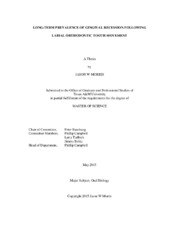| dc.description.abstract | The effects of labial incisor movements are controversial, and the effects of expansion of maxillary posterior teeth remain unknown. Therefore, this study was designed to evaluate the long-term prevalence of gingival recession following orthodontic tooth movements.
Records of 205 patients (162 female, 43 male) were obtained from two private practice orthodontists who were careful to avoid excessive labial movement of mandibular incisors and maxillary posterior teeth. Using pre-treatment (14.0 ± 5.9 years) and post-treatment (16.5 ± 6.0 years) lateral cephalograms and dental models, changes in mandibular incisor inclination and maxillary arch widths were determined. Gingival recession was measured based on post-treatment and post-retention (32.3 ± 8.5 years) intraoral slides. Associations between tooth movements and gingival recession were evaluated statistically.
There was only limited recession at the end of orthodontic treatment (5.8% of teeth exhibited recession; 0.6% exhibited recession greater than 1 mm). Recession increased long-term (41.7% of teeth), however the severity was limited (7.0% over 1 mm). Both incisor proclination and retroclination occurred, resulting in no statistically significant treatment change (-0.05 ± 6.4º). Proclination was greatest in individuals with the most upright incisors at the beginning of treatment (R = -0.575; p < 0.001). There was no relationship between the treatment changes in mandibular incisor proclination and the post-treatment changes in gingival recession. There was also no difference in recession between incisors that finished treatment at an incisor to mandibular plane angle (IMPA) of less than 95º versus those that finished at an IMPA greater than or equal to 95º. Expansion of the maxillary posterior teeth was limited (1.1 ± 2.0 mm, 0.2 ± 2.6 mm, and -0.2 ± 2.2 mm for the first premolars, second premolars, and first molars, respectively). There were weak positive correlations (0.173 to 0.407) between increases in maxillary arch widths and recession long-term.
Orthodontic treatment is not a risk factor for the development of gingival recession. Proclination of the mandibular incisors does not increase the risk for recession long-term if care is taken to avoid excessive labial movements. Expansion of the maxillary premolars and first molars does increase the risk of long-term recession, but the increase is limited. | en |


